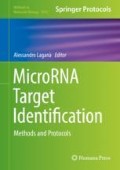Abstract
In this chapter, we present a computational method, TarPmiR, for miRNA target prediction. TarPmiR is based on emerging features of miRNA–target interactions learned from CLASH (crosslinking, ligation and sequencing of hybrids) data. First, we introduce miRNA target prediction, delineate existing methods for miRNA target prediction, and discuss their usage and limitations. Next, we describe available CLASH data, the learning of new miRNA binding features from CLASH data, and the usage of CLASH features in miRNA target prediction. Finally, we detail the computational pipeline of TarPmiR, discuss its performance compared with existing computational methods for miRNA target prediction, and present its installation and usage for miRNA target prediction. This chapter will facilitate the common understanding of CLASH data, new characteristics of miRNA–target interactions, and the use of the CLASH based miRNA target prediction tool TarPmiR.
Access this chapter
Tax calculation will be finalised at checkout
Purchases are for personal use only
References
Bartel DP (2004) MicroRNAs: genomics, biogenesis, mechanism, and function. Cell 116:281–297
Agarwal V, Bell GW, Nam JW et al (2015) Predicting effective microRNA target sites in mammalian mRNAs. eLife 4
Kuhn DE, Martin MM, Feldman DS et al (2008) Experimental validation of miRNA targets. Methods 44:47–54
Thomson DW, Bracken CP, Goodall GJ (2011) Experimental strategies for microRNA target identification. Nucleic Acids Res 39:6845–6853
Hafner M, Landthaler M, Burger L et al (2010) Transcriptome-wide identification of RNA-binding protein and microRNA target sites by PAR-CLIP. Cell 141:129–141
Helwak A, Kudla G, Dudnakova T et al (2013) Mapping the human miRNA interactome by CLASH reveals frequent noncanonical binding. Cell 153:654–665
Moore MJ, Scheel TK, Luna JM et al (2015) miRNA-target chimeras reveal miRNA 3′-end pairing as a major determinant of Argonaute target specificity. Nat Commun 6:8864
Chi SW, Zang JB, Mele A et al (2009) Argonaute HITS-CLIP decodes microRNA-mRNA interaction maps. Nature 460:479–486
Ding J, Li X, Hu H (2016) TarPmiR: a new approach for microRNA target site prediction. Bioinformatics 32(18):2768–2775
Lewis BP, Burge CB, Bartel DP (2005) Conserved seed pairing, often flanked by adenosines, indicates that thousands of human genes are microRNA targets. Cell 120:15–20
Lewis BP, Shih I-H, Jones-Rhoades MW et al (2003) Prediction of mammalian microRNA targets. Cell 115:787–798
Ule J, Jensen KB, Ruggiu M et al (2003) CLIP identifies Nova-regulated RNA networks in the brain. Science 302:1212–1215
Vejnar CE, Zdobnov EM (2012) MiRmap: comprehensive prediction of microRNA target repression strength. Nucleic Acids Res 40:11673–11683
Enright AJ, John B, Gaul U et al (2004) MicroRNA targets in drosophila. Genome Biol 5:R1–R1
Paraskevopoulou MD, Georgakilas G, Kostoulas N et al (2013) DIANA-microT web server v5. 0: service integration into miRNA functional analysis workflows. Nucleic Acids Res 41(Web Server issue):W169–W173
Loher P, Rigoutsos I (2012) Interactive exploration of RNA22 microRNA target predictions. Bioinformatics 28:3322–3323
Friedman RC, Farh KK-H, Burge CB et al (2009) Most mammalian mRNAs are conserved targets of microRNAs. Genome Res 19:92–105
Wang X (2010) Computational prediction of microRNA targets. Methods Mol Biol 667:283–295
Ding J, Li X, Hu H (2014) MicroRNA modules prefer to bind weak and unconventional target sites. Bioinformatics. btu833
Wang XW (2014) Composition of seed sequence is a major determinant of microRNA targeting patterns. Bioinformatics 30:1377–1383
Kishore S, Jaskiewicz L, Burger L et al (2011) A quantitative analysis of CLIP methods for identifying binding sites of RNA-binding proteins. Nat Methods 8:559–564
Vlachos IS, Paraskevopoulou MD, Karagkouni D et al (2015) DIANA-TarBase v7. 0: indexing more than half a million experimentally supported miRNA: mRNA interactions. Nucleic Acids Res 43:D153–D159
Wang Y, Li X, Hu H (2011) Transcriptional regulation of co-expressed microRNA target genes. Genomics 98:445–452
Ding J, Li X, Hu H (2017) CCmiR: a computational approach for competitive and cooperative microRNA binding prediction. Bioinformatics
Author information
Authors and Affiliations
Corresponding author
Editor information
Editors and Affiliations
Rights and permissions
Copyright information
© 2019 Springer Science+Business Media, LLC, part of Springer Nature
About this protocol
Cite this protocol
Li, X., Hu, H. (2019). Improving miRNA Target Prediction Using CLASH Data. In: Laganà, A. (eds) MicroRNA Target Identification. Methods in Molecular Biology, vol 1970. Humana Press, New York, NY. https://doi.org/10.1007/978-1-4939-9207-2_6
Download citation
DOI: https://doi.org/10.1007/978-1-4939-9207-2_6
Published:
Publisher Name: Humana Press, New York, NY
Print ISBN: 978-1-4939-9206-5
Online ISBN: 978-1-4939-9207-2
eBook Packages: Springer Protocols

